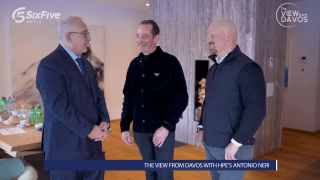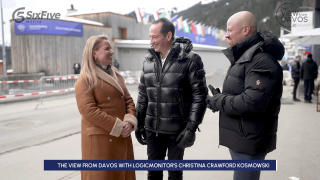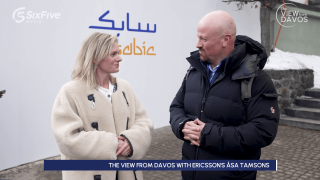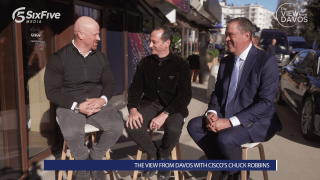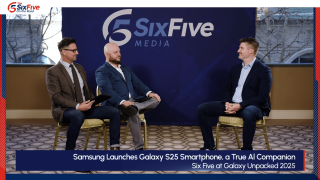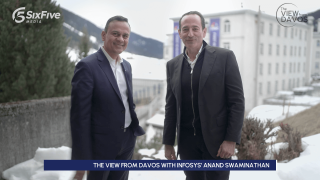New insights from Davos ❄️ – the future of AI is about value creation.
Has AI reached a pivotal point? IBM’s Rob Thomas believes it’s time to move beyond experimentation and to focus on generating real value with AI.
Patrick Moorhead and Daniel Newman are joined by IBM’s Rob Thomas, SVP, Software and Chief Commercial Officer, for a conversation on IBM’s recent initiatives and his take on the future of AI in this installment of The View from Davos.
Tune in as they cover ⤵️
- IBM’s strategic priorities and how they are shaping the future of technology and business
- Insights into the latest trends and innovations discussed at Davos
- The power of speed: AI’s ability to drastically accelerate processes – cutting cycle times from 6 months to 4 hours
- The role of Open Source & avoiding vendor lock-in to fostering collaboration for AI adoption
- Their take on building sustainable, ethical, and secure technology solutions for the future
Learn more at IBM.
Watch the video below, and be sure to subscribe to our YouTube channel, so you never miss an episode.
Or listen to the audio here:
Disclaimer: The View from Davos is for information and entertainment purposes only. Over the course of this webcast, we may talk about companies that are publicly traded and we may even reference that fact and their equity share price, but please do not take anything that we say as a recommendation about what you should do with your investment dollars. We are not investment advisors, and we ask that you do not treat us as such.
Transcript:
Patrick Moorhead: The Six Five is On The Road with a View from Davos, as you can see in this amazing background here, but we’re not here just to be on the ski slopes or sled down the hill. We’re having some great conversations here. I mean, there’s so many things going on right now. In fact, a new administration is coming in the US. There’s a lot of discussion around this. We have this ever-present question about regulation, and there’s innovation discussion at the conference as well, particularly around generative AI, things like sustainability. With that said, I’d like to bring back on the show Rob Thomas, welcome back to The Six Five.
Rob Thomas: Great to be here. Great to see you both. And how about Davos? Great to be here.
Patrick Moorhead: I know it’s great to be in Davos. It feels good.
Daniel Newman: Just for the ski slopes, I didn’t do any skiing, man. I don’t know about you.
Patrick Moorhead: Just had to throw that in there.
Daniel Newman: It’s beautiful out there, it certainly is.
Patrick Moorhead: Did my skiing while I… So Rob, a lot of stuff going on here at the show. I’m curious, what are your objectives at the show, customer, governments, what do you want to get done here?
Rob Thomas: This is an incredible place to do a lot of meetings in a short period of time. We have a very global business as you know, so I’m able to meet with businesses and governments from Indonesia to Japan to the Middle East, to people based right in the US where I live or across Europe. So in terms of the quality of meetings you get, it’s incredible with just one trip as opposed to with 100 trips. And also I do sense something different happening in Davos over the last few years, I’d say, and it’s almost the integration of public and private, meaning there’s a lot of discussion that happened here about businesses impacting governments and vice versa, and I think that can be very healthy actually.
Daniel Newman: Yeah, it is really exciting times. I mean, we’re seeing rockets being shot into space regularly, and I mean the private sector, how much it can drive, and then of course partnering with public to your point. And I know one of your very own, Head Of Research, Dario Gil is going to be taking a role in the new administration. That’s super exciting. It’s indicative of the kind of research that’s going on at IBM and that he’s driving, since we’re talking a little bit about this, love to get your take. I mean, I know new administration, that often means a lot for someone like you driving and leading such a large company. Any big thoughts on this next four years and what you really hope to see out of a Trump administration that might be strong for AI or we hear about blockchain and crypto, we’re hearing about possible M&A, what are some of the things that you’re thinking about?
Rob Thomas: First of all, we’re super happy for Dario Gil. As you mentioned, he was nominated as undersecretary for Department of Energy, which runs all the national labs, that type of thing. So we will miss him, but super happy for him because it’s an exciting area to be on the, I’d say leading edge of what’s happening in science and technology in the US and around the world. I think the thing I’m the most hopeful on, as you look out the next four years, is less regulation, meaning a business-friendly environment. We want to be able to create growth, create jobs, do M&A, and I think the incoming administration gives us a lot of opportunity to do that. So really excited about that. Growth solves every problem, and so good for the US. If the US gets growing, the difference between 2% GDP versus two and a half or three, if we could possibly imagine that, it has a remarkable impact on a per capita basis, and so to me, this is all about growth.
Patrick Moorhead: Yeah. Speaking of growth, I mean one of the big theses of what could drive that growth is obviously AI, and the latest flavor being generative AI and even agents, which I think we all believe is an incredible economic opportunity and a growth driver. I want to ask you, you have a lot of meetings with your clients, you get a certain read of where they are. A lot of folks have done their experiments, they’ve done some POCs, and now it’s this next jump to really scaling it, enterprise-wide, government-wide. And I’m curious, what is the read you’re getting on what help they need the most, and what are you doing about it to help solve those?
Rob Thomas: I think 2025 will be about value creation and AI, and think of it as almost-
Patrick Moorhead: So actually creating it.
Rob Thomas: No creating value with AI.
Patrick Moorhead: Okay, okay.
Rob Thomas: So value creation, meaning can you return to the top line or the bottom line of your business? Think almost like a curve. We did a lot of experimentation. You acknowledge that. Then many started down this path of we’ll do RAG, we’ll do fine-tuning. I think we hit a tipping point somewhere last year, where companies could actually see a return on automation of technology and operations. Starting to see that happen. Then that goes into code, which is starting to happen. That goes into AI assistance, that eventually then gets to agents, so I’m not really a believer that the only answer from here is agents. I think this is a curve where you have to do a little bit at each point, but we have to get past this point of experimentation.
Patrick Moorhead: Sure.
Daniel Newman: Yeah, that seems to be the big opportunity. We’ve done some assessments of the market. We’ve looked at, and by the way, Arvind was one of the early ones that kind of called out, I call it the prune to grow thing, and I know it was sort of one of those things that I think a lot of the media kind of misunderstood, but at first when you look at any new technology, you start to immediately look at where do we take out cost? Where do we become more efficient? How do we immediately get some return? It makes it easier to invest. We’re seeing four trillion in opportunity from agents and generative AI to be pulled out. The next though is how it sounds like you’re kind of looking at Rob is how do you put those dollars back to work to create scale like every industrial revolution in history has. I think that’s where the message sometimes gets misinterpreted, like, oh, you’re just going to get rid of four trillion of labor. Well, we want to upskill, repurpose, improve. I mean, are you sort of starting to see that? It feels like the first generation was POC, but it was also what redundant, monotonous, repetitive things can we get out and use agents and use generative and use assistance for, just curious your take there.
Rob Thomas: I think time may tell that maybe the biggest benefit of AI becomes speed, and how companies can deliver. We had lunch right before this with a number of C-suites from around the world, and two examples. One was a pharma firm that said, “We’ve gone from, we have to put a thousand things in motion to get one to now we can narrow it down to 12.” Because AI is becoming more part of the process, so that drives a ton of speed. If you’re not doing a thousand experiments and instead you’re doing 12, that’s a dramatic difference.
Daniel Newman: The right 12 is what they’re saying, right? The right 12-
Rob Thomas: Yeah. There’s enough signal now from the analysis they can do to make sure that you’re going to have higher odds of impact. Another one was a manufacturing example that said, we can cut cycle times from six months to four hours. If you can cut cycle times, that drives massive leverage and speed in a business, and that’s because AI can do things in partnership with humans that humans cannot do on their own, and I think that’s probably the biggest promise of what can happen here.
Patrick Moorhead: Rob, I meet a lot of CIOs that say that they’re having a hard time doing that sorting mechanism, going from that 100 to that 10, and it’s really a conversation about ROI. What is your guidance to folks who are in that situation, maybe not as enlightened as the folks that you just had your lunch with.
Rob Thomas: You should not underestimate the cultural impact of trying to do something on AI. Because let’s be blunt, it will disrupt how you do things. It will disrupt some amount of your skills, some amount of your employees. If you are scared of that or let that be a deterrent, then you will quickly fall behind. I’d say the positive side of that is every time there’s been new technology in the world, ultimately it’s created more jobs. It’s really been the forcing function behind people building new skills. I think people have to lean into this, but I do still talk to people that are a little worried If I do this, then I actually need a smaller team. Maybe that’s okay in the short term because that way we have a bigger team in the long term.
Patrick Moorhead: Sure.
Daniel Newman: Yeah. It’s really interesting. Rob, a couple of things. I’m going to maybe try to thread a couple of needles here, but I know you’re working on a book on value creation. I think it’s with AI. I want you to talk about that a little bit and also where the role that open is. I know, gosh, IBM has put a ton of effort into small language models. We’ve seen in our lab, we’ve actually been testing and looking at some of the work that you’ve done with Granite, and I think SLMs might be the future. Tying together how you create the value measure ROI and do it with open source collaboration, both with software and sort ecosystem. Can you kind of put those things together and share a little bit about the book as well?
Rob Thomas: Yeah, thank you. So I have a book coming in May. It’s called AI Value Creators, and I’ve worked with three people, Dario Gil, who you mentioned, he’s helped a lot. Paul Zikopoulos, Kate Soule, so the four of us have partnered together on this. We thought there was a story that wasn’t being told in AI. The story that’s being told is using an LLM, use ChatGPT. Use a chatbot. We thought that underplayed what you described as the four trillion opportunity. Maybe it’s even more than that. So think of this as a playbook for anywhere from the C-suite to a developer for how to think about what’s happening in an AI, how you get value out of it. The connection between data and AI, it sounds obvious to you guys. It’s not obvious to every company I would say. Step one is often make your data ready for AI, I would say. And all these pieces together we’re trying to build, I guess I’d say kind of a playbook for the next three to five years on how you get value from AI.
Patrick Moorhead: Yeah, Rob recently, and I don’t know if it was just the fourth quarter of last year that these conversations started to pop up, but the CIOs were saying, “Okay, I got my data in alignment. I did some incredible magic tricks. I figured out RAG. I either did a lot of RAG or I did an SLM or some combination and this thing works, but I can’t get the people in the company to use it and adopt it.” Are you addressing that in your book, any tips and tricks for how that, because this is a new one that has popped up for me. In fact, a Fortune 50 tech company, a CIO I had a conversation with, “It works. It’s amazing. I can’t get my people to use this thing.”
Rob Thomas: I think it comes down to there’s the cultural issue we talked about, there’s also a skills issue, and there’s also just a change management issue. If you’re adopting this technology and using it, you actually don’t have to do everything you’re doing today. You can probably do something different. So I think we all have to be a little patient that this takes some time. One reason back to the question on open source, we’ve been so focused on making this happen in open source is that brings a groundswell of support from any skill level. Certainly starting with developers, anybody can contribute, anybody can participate in what’s happening. That kind of reduces, I’d say the barrier to adoption, getting started. And also solves the fear of many companies have this fear, we’re going to get locked in. If we go down the path with one large language model, we are forever stuck in that. Open source prevents lock-in, so that’s a good point of leverage.
Patrick Moorhead: Yeah. It’s funny, this reminds me a lot of the debates we had in the early days of hey, ERP, business BPO, business process optimization, right? Getting people to do something different. I’m pretty optimistic, because this industry’s been through this before. There are certain generations who haven’t, and I think there’s a lot we can learn from the past to chart out an amazing future.
Rob Thomas: To give you a sense though, in our own story in IBM, we shared last year that we’ve driven $2 billion in cost out of the business through using AI. So I do think it helps us credibility-wise to walk in and tell people, “This is how we’re doing it.”
Patrick Moorhead: Sure.
Rob Thomas: In the development of our own products, we now are generating 6% of the code that we write with generative AI, using watsonx Code Assistant. Now, I know other companies give huge numbers, to be honest I’m incredibly skeptical of that. We’re at 6%, I think we can get to 20, 25%, which would be amazing, but even 6% at this point, that is a huge leverage adding on to the super-talented engineering team that we have.
Patrick Moorhead: Sure.
Daniel Newman: You’ve been able to move really quickly. Maybe would like to end with a bit of a culture question since you’ve been talking a little bit about what makes it happen, and we just did a landmark study, probably one of the largest of its kind. Talked to 213 of your peers, CEOs of companies with more than a billion of turnover, and we did it in partnership with a management consulting firm Kearney, and we were trying to understand, one of the big things was the adoption, and we learned something that basically companies that are struggling to adopt and successfully deploy AI, Rob, are also companies where the CEOs and top executives have held it too close, meaning they’re trying to kind of joystick it is the way I’m explaining it. You’re seeing it from both sides. You are customer zero, and I know Arvind’s passionate. You’re passionate. You’re also, through the Consulting Advantage program and through your customers that deploy your software, you’re seeing these deployments go everywhere. Any thoughts on how AI proliferates in the organization successfully, because we’re seeing almost 80% of companies that are failing, it’s because they’re basically are saying the CEOs held it and the board held it too close.
Rob Thomas: I think the companies that hold it close, the C-suite is probably not using it themselves. So the one thing I talk to my team about a lot is how much are you using it in your day-to-day job? I use it a ton, but that’s not obvious. A lot of people project as I know this is happening that’s for other people, that doesn’t set tone for an organization, so you have to be a user before you can convince others to use it I would say. So that’s probably the biggest thing we’ve tried to drive in IBM is you have to lead by example on these topics.
Daniel Newman: Yeah. It feels a little bit like the historic digital transformation where it’s like, “Why is it not working? I told everybody to digitally transform.” It’s like, okay, what does that mean? But AI’s happening so fast. So anyways, Rob, I wanted to just say thank you so much for spending some time with us here. Congratulations on the book.
Rob Thomas: Thank you.
Daniel Newman: Congratulations on the progress. Of course, this should be a really big year for IBM. I mean all these POCs turn to mass deployments, Rob, this should start to show up in the numbers. I know you can’t talk about that, but we’ll keep our eyes on it. We’ll be in touch and we’ll talk more soon.
Rob Thomas: We are excited. One preview I’ll give you, a year ago I think we announced Concert, which was how do you apply AI for resiliency in technology systems? We’re super pleased with the progress there. I think we kind of hit a pain point at the right time on resiliency, which is, every company’s trying to say, “How do I have an infrastructure that can stand the test of time, is not going to be exposed to threats.” I think we hit something with Concert, so you’ll see more on that in May.
Patrick Moorhead: Looking forward to it. Nice little tip there.
Daniel Newman: Yeah. All right, Rob, thanks so much for joining us. I’m sure we’ll do it again sometime in 2025. Catch you soon, and thank you everybody for tuning in, being part of Six Five On The Road, a View from Davos. Subscribe, be part of all of the coverage that we had here this week at the World Economic Forum. It’s been a big week so far and it’s only the beginning. But for now we got to say goodbye. See you all later.


